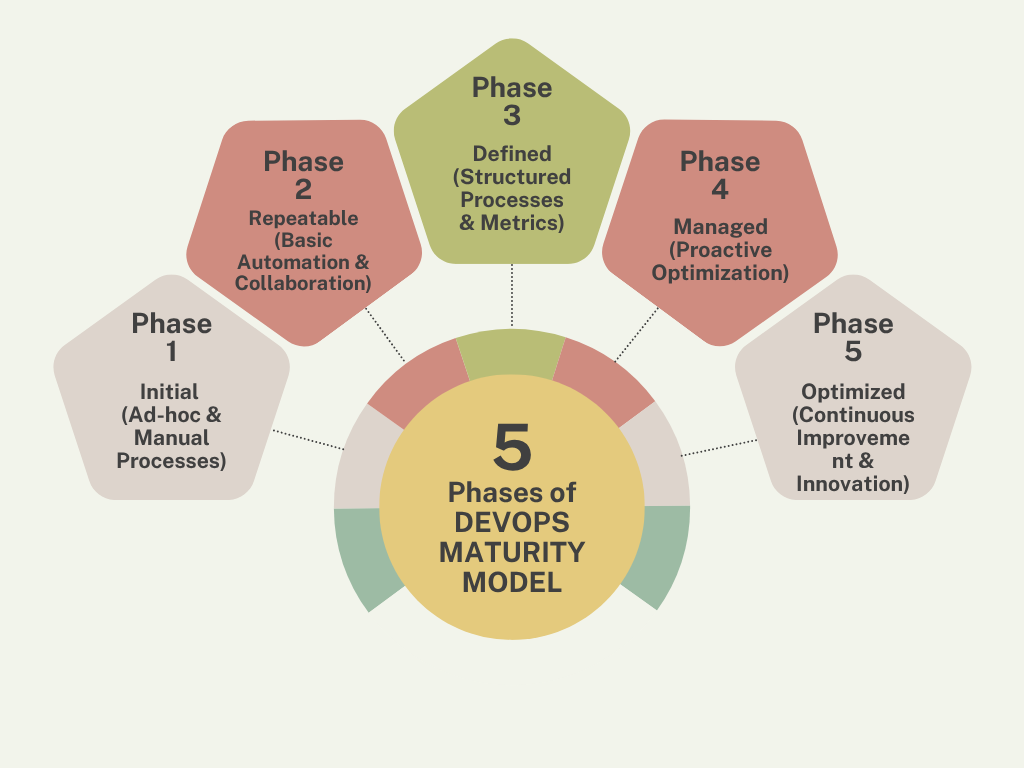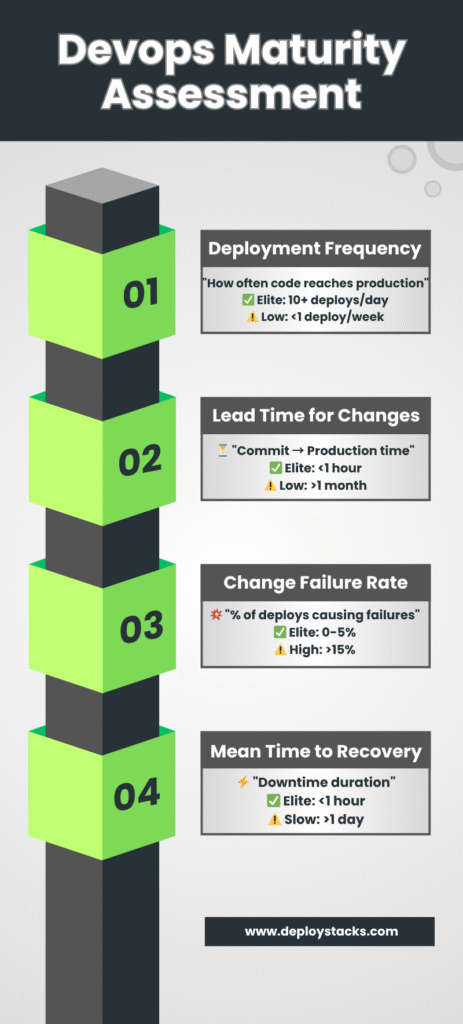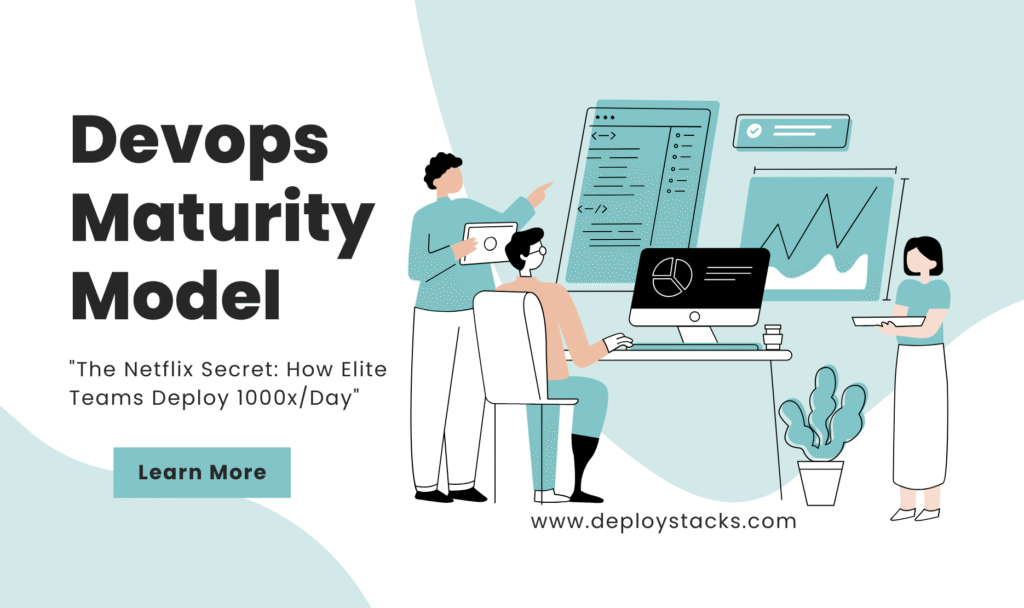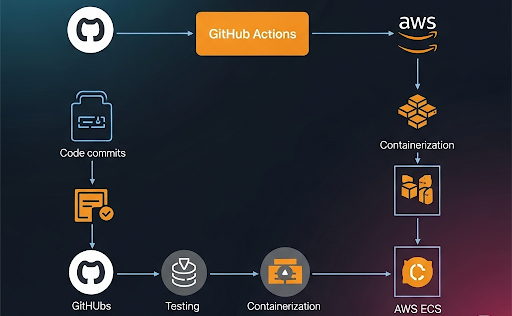DevOps Maturity Model 5 Phases
Introduction
DevOps has transformed how organizations develop, deploy, and maintain software. However, implementing DevOps effectively requires understanding where your organization stands and how to progress. The DevOps Maturity Model provides a roadmap with 5 phases, each representing a higher level of efficiency, automation, and collaboration.
In this article, we’ll explore each phase in detail, including key characteristics, real-world examples, and actionable steps to advance to the next level. We’ll also include a flow diagram to visualize the journey from manual processes to full DevOps optimization.

The 5 Phases of DevOps Maturity Model
1. Phase 1: Initial (Ad-hoc & Manual Processes)
Brief: The starting point for most organizations, where processes are unstructured, manual, and prone to errors. Teams work in silos, leading to inefficiencies and frequent failures.
Characteristics:
- Siloed teams (Dev vs. Ops) with minimal collaboration.
- Manual deployments and inconsistent processes.
- High risk of errors and slow release cycles.
How to Improve Devops Maturity:
- Introduce basic CI tools (Jenkins, GitLab CI).
- Encourage cross-team communication to break down silos.
2. Phase 2: Repeatable (Basic Automation & Collaboration)
Brief: Organizations begin adopting automation for repetitive tasks, reducing errors. Teams start collaborating, but processes are still not fully optimized.
Characteristics:
- Partial automation (e.g., automated builds, basic CI pipelines).
- Early-stage monitoring (reactive rather than proactive).
- Some team alignment, but workflows remain inconsistent.
How to Improve:
- Standardize Infrastructure as Code (Terraform, Ansible).
- Implement basic monitoring (Prometheus, Grafana).
3. Phase 3: Defined (Structured Processes & Metrics)
Brief: DevOps practices become standardized with documented pipelines, automated deployments, and performance tracking. Teams follow consistent workflows.
Characteristics:
- Well-defined CI/CD pipelines with automated deployments.
- Infrastructure managed as code (IaC).
- Monitoring and logging in place (ELK Stack, Datadog).
How to Improve Devops Maturity:
- Introduce blue-green deployments for zero downtime.
- Expand observability (distributed tracing, log analytics).
4. Phase 4: Managed (Proactive Optimization)
Brief: Organizations shift from reactive to proactive operations, leveraging automation, security integration, and predictive analytics.
Characteristics:
- DevSecOps—security embedded in CI/CD pipelines.
- AIOps & predictive monitoring (ML-driven anomaly detection).
- Automated feedback loops for continuous improvement.
How to Improve:
- Adopt shift-left security (early vulnerability scanning).
- Implement self-healing infrastructure (auto-recovery from failures).
5. Phase 5: Optimized (Continuous Improvement & Innovation)
Brief: The highest level of DevOps maturity, where systems are fully automated, self-healing, and driven by data. Innovation happens rapidly with minimal disruptions.
Characteristics:
- Full automation with near-zero manual intervention.
- ML-driven incident prevention and self-optimizing systems.
- Business and IT aligned for rapid, high-quality releases.
How to Sustain Maturity:
- Continuously experiment with emerging trends (GitOps, Serverless).
- Foster a culture of learning and innovation.
Tabular Comparison of DevOps Maturity Model 5 Phases
Here is a simplified tabular comparison of the phases of Devops Maturity Model for better understanding of the concept.
| Phase | Name | Key Characteristics | Tools to Adopt | Team Culture | Risk Level |
| 1 | Initial | Manual processes, siloed teams | FTP, Shared drives | Reactive, blame culture | High |
| 2 | Repeatable | Basic CI automation | Jenkins, Git | Emerging collaboration | Medium-High |
| 3 | Defined | Standardized CI/CD, IaC | Terraform, Kubernetes, Prometheus | Proactive, documented SOPs | Medium |
| 4 | Managed | DevSecOps, predictive monitoring | Snyk, Chaos Monkey, AIOps tools | Cross-functional ownership | Low-Medium |
| 5 | Optimized | Self-healing systems, ML-driven ops | Serverless, GitOps, AutoML | Continuous innovation | Low |
Devops Maturity Assessment
The best way to access Devops Maturity is using DORA. Here’s a concise explanation for each DORA (DevOps Research and Assessment) metric:
- Deployment Frequency → How often your team successfully releases to production.
- Lead Time for Changes → How long it takes from code commit to production deployment.
- Change Failure Rate → Percentage of deployments causing failures or rollbacks.
- Mean Time to Recovery (MTTR) → How quickly you restore service after an incident.
These four metrics help measure DevOps performance, efficiency, and reliability. 🚀

DevOps Maturity Model 5 Phases: Case Studies with Verified Examples
| Phase | Real Company | Challenge | Solution | Outcome | Source |
| 1: Initial | HSBC (2016) | Manual banking app deployments took weeks | Adopted Git + Jira for basic tracking | Cut release cycles by 30% | HSBC DevOps Case Study |
| 2: Repeatable | Etsy (2012) | “Fear of deployments” due to failures | Implemented CI/CD with Jenkins + Chef | 50+ deploys/day (from 1/week) | Etsy Engineering Blog |
| 3: Defined | Target (2019) | Black Friday crashes from monolithic systems | Moved to Kubernetes + automated CI/CD | Handled 2M+ peak orders/hour | Target Tech Blog |
| 4: Managed | Capital One | Security risks in cloud migration | DevSecOps with automated compliance checks | 80% faster secure releases | Capital One DevOps Report |
| 5: Optimized | Netflix | Global streaming reliability at scale | AI-powered auto-remediation + Chaos Monkey | 99.99% uptime with 1,000+ daily deploys | Netflix Tech Blog |
Conclusion
You’ve just explored that DevOps maturity is an evolutionary journey, not a one-time goal. Most companies start with chaotic, manual processes (Phase 1), but by adopting best practices, they can reach full automation and innovation (Phase 5).
Drop a comment below—I’d love to hear about your challenges and wins!
Pro Tip: Bookmark this page and the website and share it with your team. The next time someone says “Our DevOps process is fine,” you’ll have the perfect maturity benchmark to discuss!
🚀 P.S. Want me to deep-dive into a specific phase? Let me know—your feedback shapes our next guide!




It was really helpful. Thank you for his detailed analysis.